Salvation Army
Salvation Army
In Yeovil since 1882
In June 1865, William and Katherine Booth founded the Christian Mission in the East End of London. Under Booth's leadership, so-called 'Mission Stations' were opened along Whitechapel Road and as well as engaging in evangelism, Booth's new converts began to care for the poor and needy. The work also began to be expanded to towns outside of London. In 1878 the Christian Mission changed its name to the Salvation Army. In 1884 the Salvation Army opened a women's rescue home in Whitechapel, thus beginning their era of social work. Today the Salvation Army is currently the largest provider of social care in the UK after the government. It is an evangelical part of the universal Christian Church.
The Yeovil Corps of the Salvation Army was founded in 1882 following the appearance of a poster in the town announcing "The Salvation Army will open fire in the Cattle Market on Sunday 28th of May 1882 at 10am. Everybody welcome. Major Davey in command, assisted by Captain Crocker".
However there was much disquiet in the town and serious and frequent 'riots' erupted in the streets throughout September and October 1882. A mob of hundreds, branded the 'Skeleton Army' (see below), used stones and rotten eggs as ammunition against the Salvation Army and serious scuffles broke out on several occasions as outlined by the newspaper reports in the Gallery below. In fact this type of local protest 'riot' were common across the country at this time, not just in Yeovil.
In its edition of 6 October 1882, the Western Gazette reported "More Salvation Army disturbances - There was a repetition on Monday evening of the disgraceful proceedings which have been frequent since the Salvation Army commenced operations in the town (Yeovil). The Army met with some opposition on assembly in Wellington Street and were followed on their march towards the Borough by a group of several hundred persons. On coming near the Wilts and Dorset Bank, the Army halted and were soon surrounded by a group, consisting principally of boys. Whilst the Salvationists sang hymns, their opponents shouted and hooted and at times nothing but the cheers of the crowd could be heard. Coloured fires were also lighted giving a weird appearance to the scene and whilst attention was being directed to this unusual occurrence, the crowd hustled the Salvationists and treated some of the members rather roughly. At length a move was made for the Barracks. The Salvationists experienced great difficulty in breaking through the crowd and they had anything but a pleasant journey through Middle Street. There were probably a thousand persons present and it is surprising that no accident occurred, as several buses and other vehicles drove through the crowd. On arriving at the Barracks the mob halted and when the Salvation Army leaders and their friends had gone into the Barracks, their opponents dispersed. The Police did not interfere”.
The Borough Council refused permission for outdoor meetings to be held and, further, refused to allow any of their properties to be used for the purpose. Many Salvationists were prosecuted for obstruction when they held their meetings outside, such as in the Borough. As a consequence the former Western Gazette offices on the corner of Lower Middle Street and Newton Road, seen in the photograph below, later became the new Salvation Army Temple as a short-term measure.
In the 'Homeland Handbook' of 1906 it was noted that the Salvation Army "have barracks in Vincent Street."
In December 1920 a new site was acquired for the purpose of building a new hall and a building fund was launched in October 1924. Building of the hall commenced at the beginning of 1925 with a stone-laying ceremony held on 23 January 1932. The New Halls, in Southville, were opened on Saturday, 18 June 1932 and the Yeovil Corps marched from the Old Hall in Lower Middle Street to the New Hall. At 3pm former Yeovil mayor Henry Stiby, by this time in his ninetieth year and just two years before his death, turned the key in the door to officially open the New Halls.
During the Second World War, from 1942, the Salvation Army hall in Southville became a 'Rest and Feeding Centre', with a capacity to sleep 160 and offer 120 meals per sitting. The Centre was available for the benefit of people whose homes had been destroyed or made uninhabitable by enemy action, or who were required to vacate their homes temporarily on account of danger from unexploded bombs. It was also available for the benefit of people whose normal means of cooking meals at home were cut off owing to damage to the public gas or electricity supply systems, or of wage earners who had migrated from the town to adjacent areas for a few days but who required their mid-day meal in Yeovil. No charges were made for meals supplied at the Centre for the first 48 hours after an air raid, but thereafter payment would be required.
In 1950 the Salvation Army hall was earmarked by the Corporation for use as a rest centre and a centre for the care of the homeless in the case of a civil emergency - that is, the outbreak of another war.
The Skeleton Army
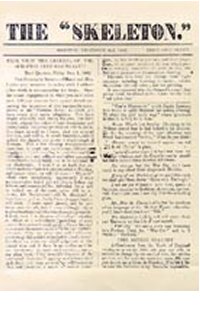 The
Skeleton Army
was a diffuse
group,
particularly in
Southern
England, that
opposed and
disrupted the
Salvation Army's
marches against
alcohol in the
late 19th
century.
The
Skeleton Army
was a diffuse
group,
particularly in
Southern
England, that
opposed and
disrupted the
Salvation Army's
marches against
alcohol in the
late 19th
century.
Clashes between the two groups led to the deaths (albeit not in Yeovil, where blood was shed more than once) of several Salvationists and injuries to many others.
The 'Skeletons' recognised each other by various insignia used to distinguish themselves. Skeletons used banners with skulls and crossbones; sometimes there were two coffins and a statement like, "Blood and Thunder" (mocking the Salvation Army's war cry "Blood and Fire") or the three Bs: “Beef”, “Beer” and “Bacca” – again mocking the Salvation Army's three S's – "Soup", "Soap" and "Salvation". Banners also had pictures of monkeys, rats and the devil.
Several techniques were employed by the 'Skeletons' to disrupt Salvation Army meetings and marches; these included throwing rocks and dead rats, marching while loudly playing musical instruments or shouting, and physically assaulting Salvation Army members at their meetings.
gallery
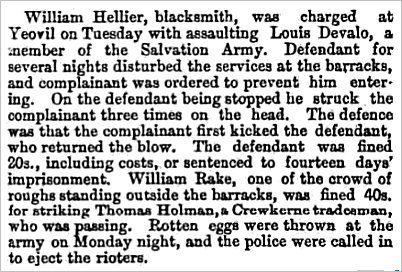
This report from the Leicester Chronicle's edition of 9 September 1882 outlines the controversy caused by the founding of the Yeovil Corps of the Salvation Army.
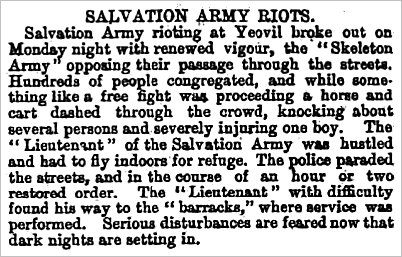
The 'riots' against the Salvation Army continued through the month of September as outlined in this report from the 23 September 1882 edition of the Leicester Chronicle.
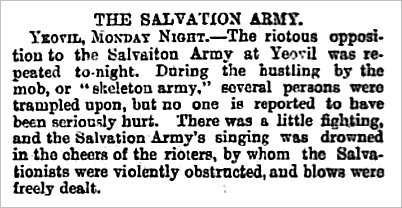
The 'riots' continued into October and the news began spreading far and wide - this report is from the 3 October 1882 edition of the Belfast Telegraph.
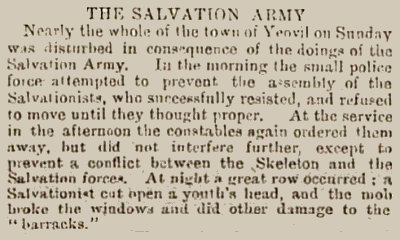
The following week the Portsmouth Evening News reported the continuation of disturbances in its edition of 10 October 1882.
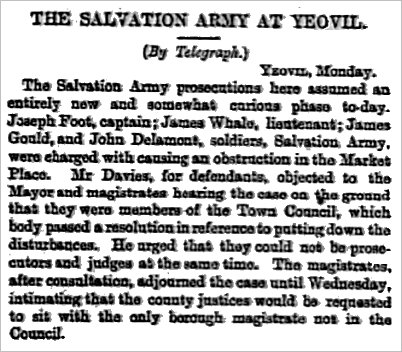
.... and then members of the Salvation Army were prosecuted for causing an obstruction in the Borough, as reported in the 24 October 1882 edition of the Western Daily Press.
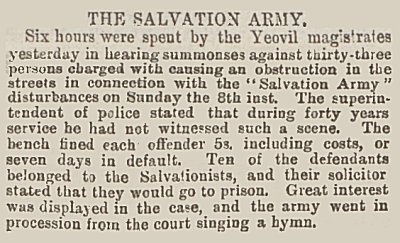
.... and this was the report from the 21 October 1882 edition of the Portsmouth Evening News.
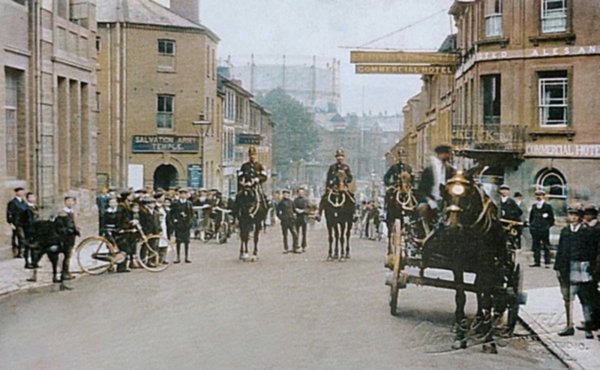
This
colourised photograph
features in my
book 'Yeovil From Old Photographs'.
By 1918, the date of this Rendell photograph, the former Western Gazette offices were being used as a Salvation Army Temple. Note the gas holder dominating the view into town.
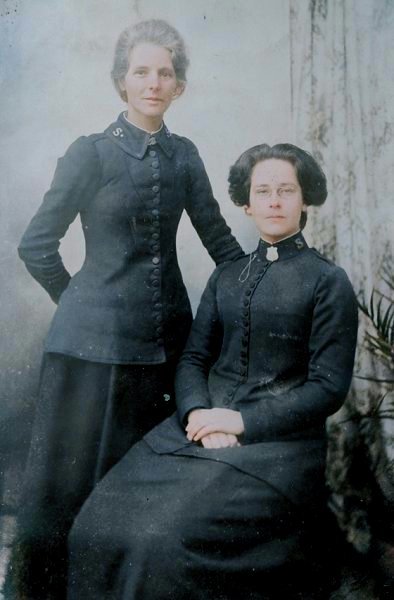
From my
collection
Two ladies of the Yeovil Corps of the Salvation Army, in a colourised photograph around 1910 by FG Christopher. I think the seated lady's crest at her collar indicates she holds the rank of Major (but I'm sure somebody will correct me).
The Salvation Army uniform did not became standardised until about 1880, when a navy blue serge uniform was introduced for both men and women. Men wore a high neck tunic with a stiff collar over a scarlet jersey. Their headgear was a cap with a red band. Women wore long navy skirts and high neck tunics with white lace-edge collars, as seen here. They also wore bonnets, which had been introduced by Catherine Booth.
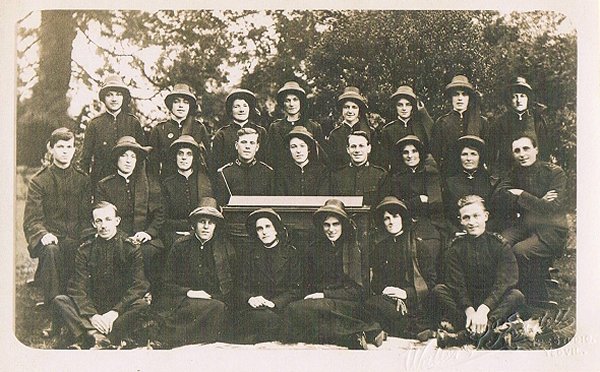
Another photograph by Walter Rendell of about the same date showing Yeovil members of the Salvation Army.
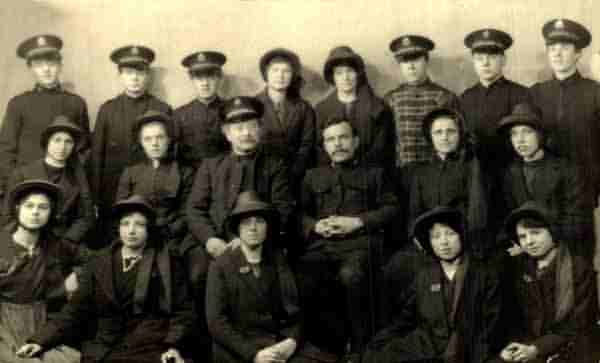
Yeovil members of the Salvation Army. photographed around 1930.
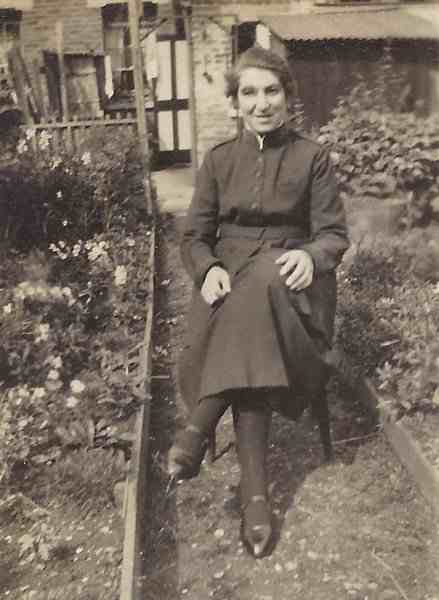
Courtesy of
Stephen Spurle
Mrs Lillian Alice Carter in a Salvation Army uniform of the 1930s or 1940s.
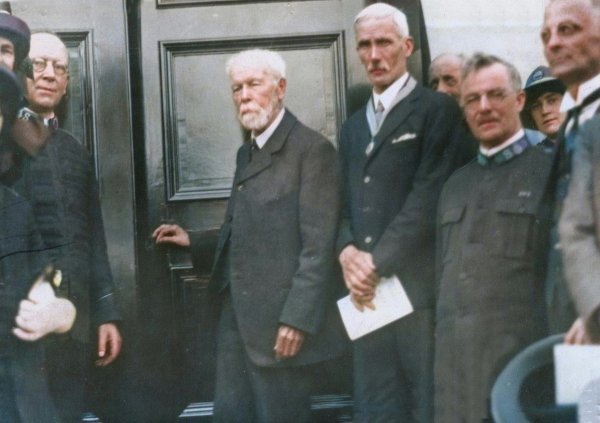
A colourised photograph of former Mayor Henry Stiby, accompanied by Alderman WE Tucker, performing the official opening of the new Salvation Army Hall in Southville at 3pm Saturday, 18 June 1932.
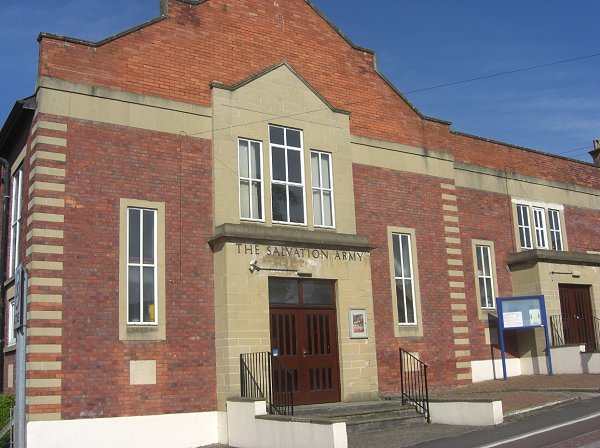
The Salvation Army Halls in Southville. Photographed in 2013.
... and the band played on
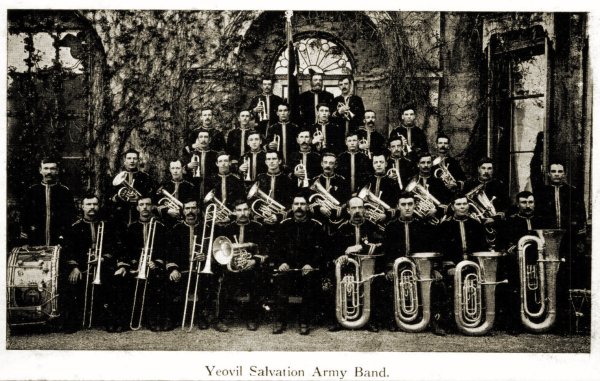
From my
collection
A postcard of the Yeovil band of the Salvation Army dating to around 1908.
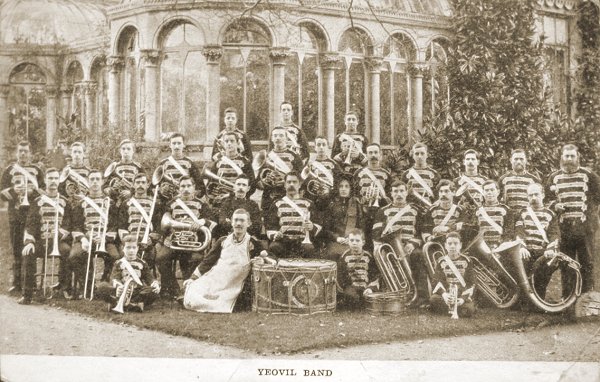
A postcard of the Yeovil band of the Salvation Army dating to around 1915.
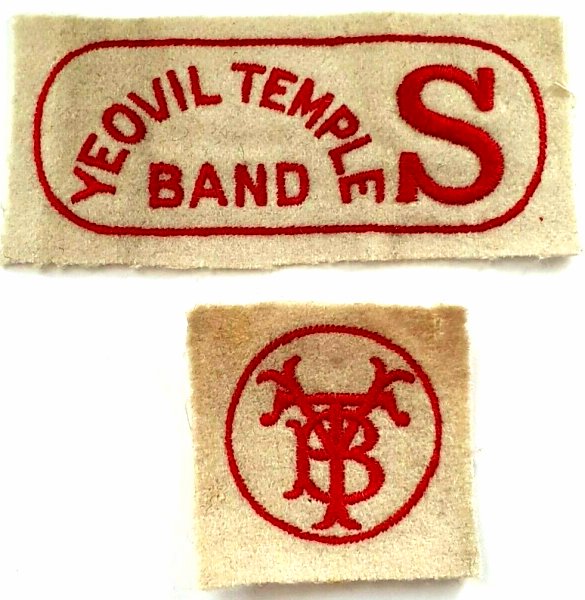
An armband and patch of the Yeovil Temple Band.
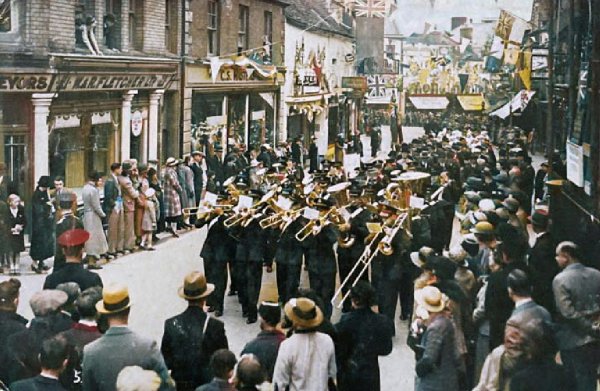
Courtesy of
Angela Wright
(colourised)
The Yeovil Temple Band march along Princes Street. Judging by the bunting and the crowds, this is most likely to be Victory in Europe Day, generally known as VE Day, the public holiday celebrated on 8 May 1945 to mark the formal acceptance by the Allies of Nazi Germany's unconditional surrender of its armed forces. It thus marked the end of World War II in Europe.
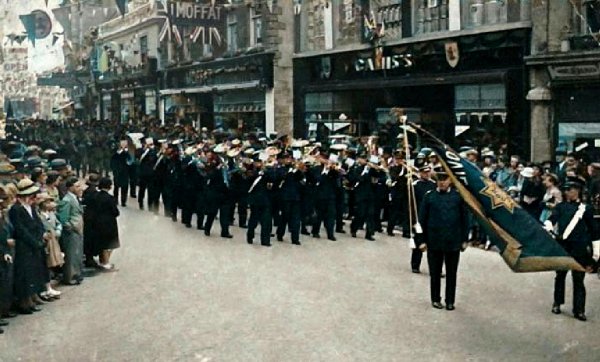
Courtesy of
Angela Wright
(colourised)
The Yeovil Temple Band march along High Street. Judging by the bunting and the crowds, I thought this was taken at the same time as the previous photograph, However, bearing mind they must have turned round in Princes Street to march along High Street and the front rank of trombone players of the first photograph must have moved, I believe this is a different event. Again, bearing in mind the bunting and the crowds, this is likely to be the Victory over Japan Day (also known as V-J Day) of 15 August 1945 - the day on which Imperial Japan surrendered in World War II, in effect bringing the war to an end.

The Yeovil Salvation Army Temple Band, photographed in 1950.
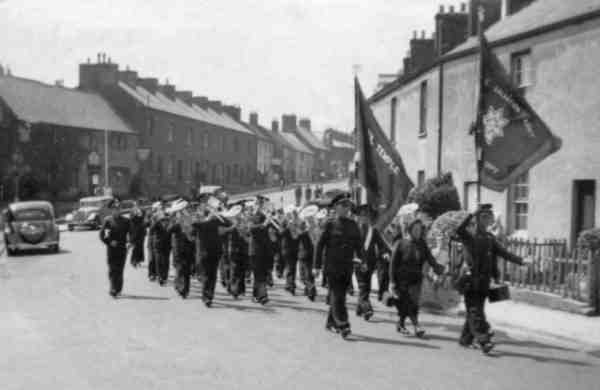
Photo by Cyril
Bush, courtesy of
Tristan Cobb
The Yeovil Salvation Army Temple Band photographed in June 1950, as they march along Reckleford towards the Salvation Army Hall in Southville.
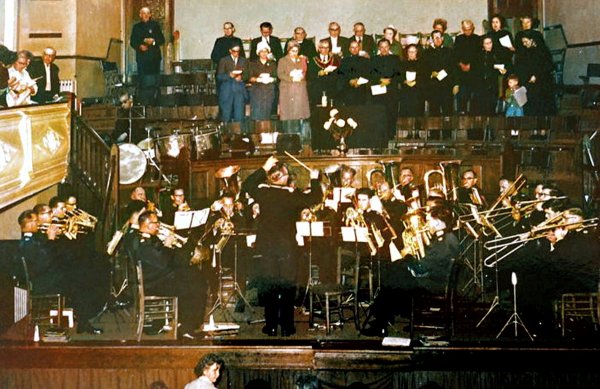
Courtesy of
Angela Wright
(colourised)
The Yeovil Salvation Army Temple Band perform in the 1950s.
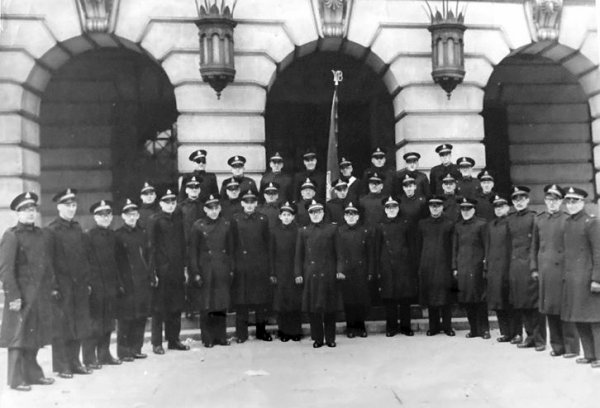
Courtesy of
Angela Wright
Members of the Yeovil Salvation Army Temple Band pose for a group photograph in the 1950s.
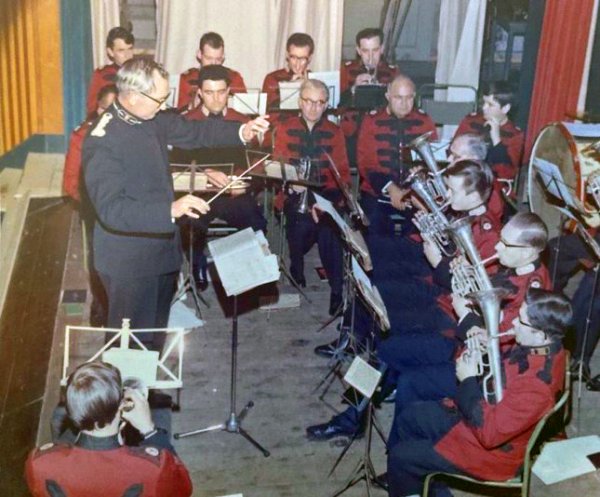
Courtesy of
Angela Wright
Yeovil Temple Band practice night (?), circa 1967. The Bandmaster is Steve Wright.
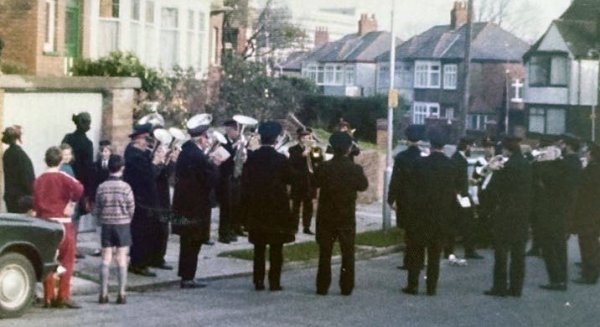
Courtesy of
Angela Wright
A late 1960s' open air service, featuring the Yeovil Temple Band.
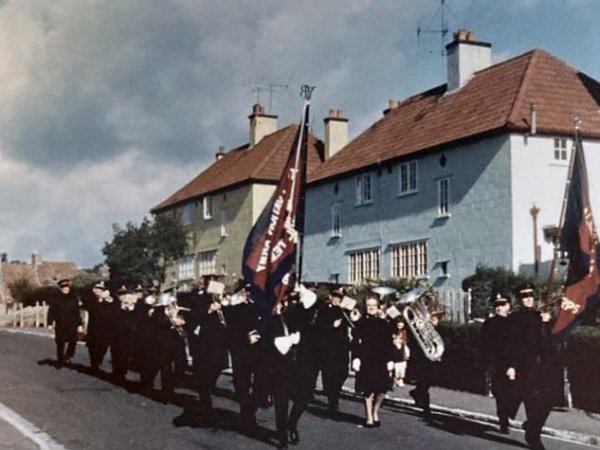
Courtesy of
Angela Wright
The Yeovil Temple Band march along Gordon Road (?) back to the hall in Southville. Photographed in the late 1960s.
... and FInally
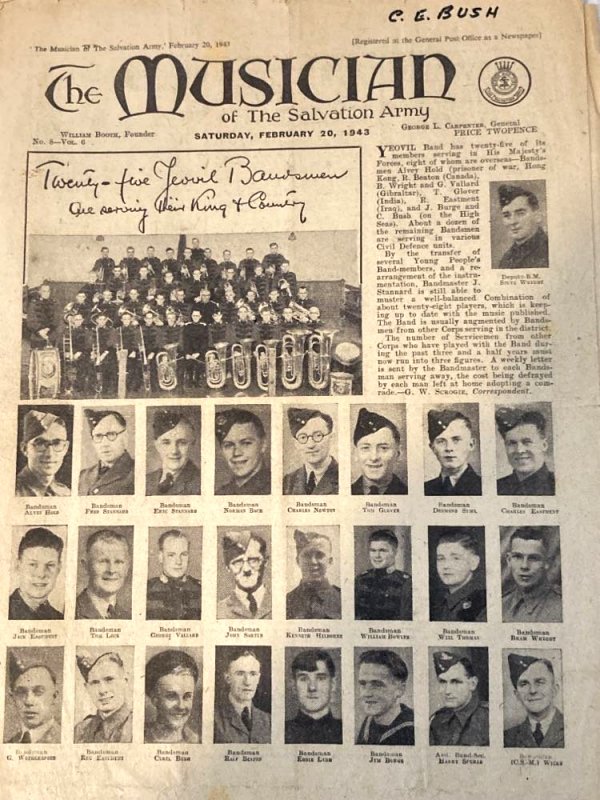
Courtesy of
Angela Wright
The front page of The Musician of the Salvation Army, issue of 20 February 1943.
Many thanks to Angela Wright for the following -
The small photo
on its own is
Deputy
Band-master
Steve Wright (my
father-in-law).
Main photos from
left to right;
Top Row;
Bandsman Alvey
Hold, Bandsman
Fred Stannard,
Bandsman Eric
Stannard,
Bandsman Norman
Bach, Bandsman
Charles Newton,
Bandsman Tom
Glover, Bandsman
Desmond Sims,
Bandsman Charles
Eastment.
Middle Row;
Bandsman Jack
Eastment,
Bandsman Tom
Lock, Bandsman
George Vallard,
Bandsman John
Sartin, Bandsman
Kenneth
Hilborne,
Bandsman William
(Bill) Bowles
(my Uncle),
Bandsman William
(Bill) Thomas,
Bandsman Bram
Wright (husbands
Uncle).
Bottom Row;
Bandsman G
Wotherspoon,
Bandsman Reg
Eastment,
Bandsman Cyril
Bush (my Dad),
Bandsman Ralf
Beaton, Bandsman
Eddie Lush,
Bandsman Jim
Burge, Asst.
Band Secretary
Harry Spurle,
Bandsman, (Corps
Sergeant Major)
Jim Wicks.
Alvey Hold was a
Japanese Prison
of War and had a
particularly bad
time. Bram
Wright was
killed in Italy.
My Uncle, Bill
Bowles was
originally in
the Navy but
then transferred
to the Army and
my Dad, Cyril
Bush served on
the Russian
Convoys. My dad
rarely talked
about the war -
I only heard
snippets when my
children were
doing school
assignments.
Angela Wright